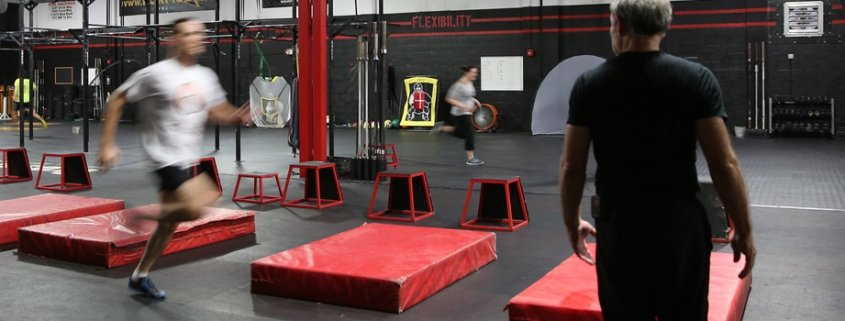Training: How to Increase Running Speed in One Simple Step
Whether you can maintain your newfound speed for the required distance, say 40 yards or 100 meters, is a matter of training and your skill level. Whether you can run faster than Usain Bolt is a matter of your physical stats and genetic potential (p.189) in addition to training and skill level.
One thing is for sure, however, whatever your current running speed is, you can run faster immediately by simply changing just one thing. Nothing else will give you the same result.
Traditionally recommended things for increasing of speed in reality prevent you from running faster. The higher you attempt to raise your knees, the harder your attempt to pump your arms or hit the ground, the more you attempt to push off and toe off – the slower you make yourself. All of those things require extra effort and throw you off balance, so you end up exerting more effort without any increase in speed. You, most likely, have experienced that and know how frustrating it can be.
What you really want to do is:
- stay relaxed yet focused,
- apply minimal effort and
- use natural forces to your advantage.
That’s natural running at its best.
Now, the question is: how do you use natural forces to run? To say ‘stay relaxed yet focused’ is to describe how you should feel not what you should do. So how do you instruct someone what to do in order to tell them how to run? That is what the Pose Method® of Running is all about. If you’re not familiar with it – go ahead and follow that link, it will make the following paragraphs clearer.
How to Increase Your Running Speed
Commonly given advice is more of an advice for a training session or on running form. You’re told to “warm up, stay upright, land on forefoot, focus on posture”, etc. While improving your running form will definitely make you faster and more efficient in general, it still doesn’t answer the main question – how do you actually increase your running speed? What do you do? Especially if you’re already in motion? Knowing how to do that will make all the difference during a race or the game.
Running faster is about your skill, not strength or power. A certain level of strength is absolutely necessary in order to withstand such a physically demanding activity as running, but your muscles do not produce your speed. Muscles serve a different purpose.
To run faster you need to master just one thing – angle of falling. It’s your ‘gas pedal’. Fall forward more – run faster. Fall forward less – run slower. Within the Pose Method framework, that is all that needs to happen in order to unleash your speed. Your speed is under your command when you learn to operate with the angle of falling.
By-products of Increased Speed
When you increase your speed several things happen as a result. The important part here is to understand where your efforts should be applied.
- Stride Frequency will have to be increased. To maintain speed and to prevent tumbling over you’ll have to change your support faster. This is one of the reasons that strength training is so important for runners. In sprinting it is the intensity of speed, in long distance it is the extent of miles to be continuously covered that necessitates the ability to pull and keep on pulling your foot up in order to keep changing support in order to keep moving. A good thing here is that stride frequency of 180 and above activates a natural muscle-tendon elasticity mechanism
Keep in mind, that you can easily increase the frequency of change of support and still stay in one place. You won’t move forward until you introduce a degree of falling forward to your movements.
- Magnitude of Pulling your foot from support and under your hips increases and do so by itself, i.e. no effort on your part is required. Due to increase in angle of falling and stride frequency, your foot will come up higher than normal, right under your buttocks. The key is to understand that you won’t need to do it, the inertia and other forces interacting will do it for you. In fact, the trajectory of your entire leg will map itself out.
Recommended Reading:
- Gravity’s role in accelerated running – a comparison of an experienced Pose® and heel-toe runner. (International Society Of Sports Biomechanics, XXV11, 374-377, 2009)
- Geometry of Running. (European College Of Sport Science, July 5-8, 2006 Switzerland)
- Runners Do Not Push Off the Ground But Fall Forwards Via a Gravitational Torque. (Sports Biomechanics Journal, 2007)
- Романов, Н. С. Роль силы тяжести в ускорении тела бегуна вперед / Н. С. Романов, А. И. Пьянзин, Е. В. Никитина, В. И. Васильев / Актуальные вопросы физической культуры и спорта: материалы Всероссийской научно-практической конференции. – Новочебоксарск: НФ РГУФКСМиТ, 2012. – С. 75–80 (0,31/0,08 п.л.).
- The Independent Effects of Gravity and Inertia on Running Mechanics. The Journal of Experimental Biology 203, 229–238 (2000)
- Muscle Activity in Running. The Extensor Paradox Experiment. Biomechanics of Distance Running. Human Kinetics Books, 1990
- Bartlett, R., Romanov, N., Fletcher, G. A Case Study of Two National Standard Sprinters Completing a Pose and Traditional Sprint Start Technique. Journal of Athletic Enhancement, Vol 3; 2014 doi:10.4172/2324-9080.1000145

 Pose Method Publishing, Inc
Pose Method Publishing, Inc

 Pose Method Publishing, Inc
Pose Method Publishing, Inc
I understand that muscles are used to sustain the body during running and they are not used to increase velocity because this is only due to the interaction between body weight and gravity (the falling angle). It’s important to do strength training in order to have more efficient muscles in terms of elasticity and reactivity of them during running. It’s wright? Thanks